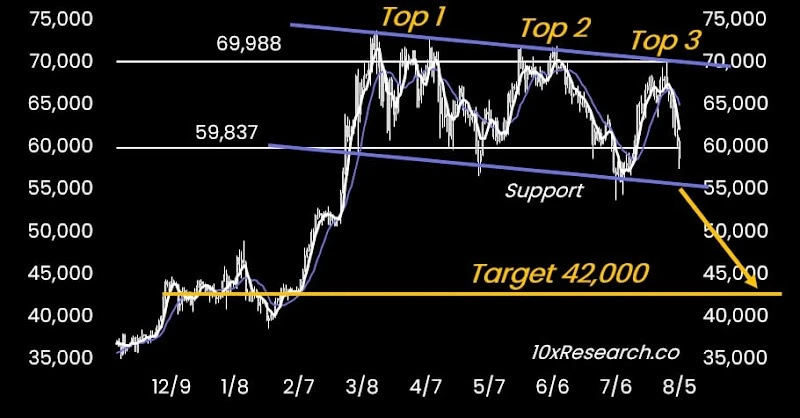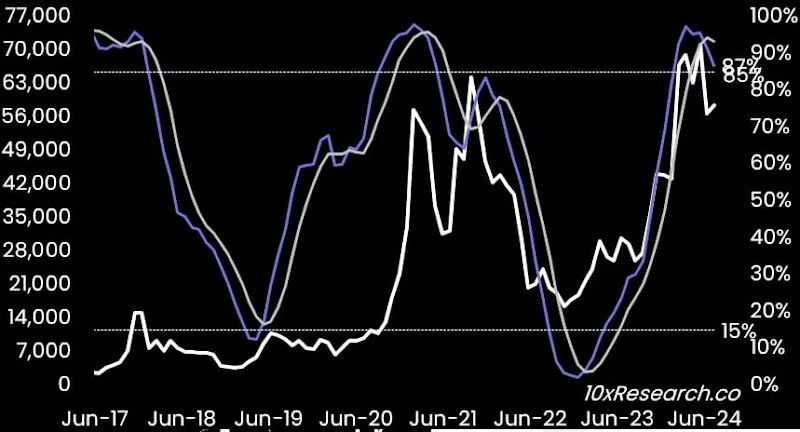This article comes from Bitcoin: This Might be the BIG ONE
Original author: Markus Thielen
Compiled by: Odaily Planet Daily Husband

Despite the prevailing bullish sentiment in Bitcoin and the cryptocurrency space, there are times when it is crucial to protect wealth or take advantage of significant price drops.
On October 3, 2023, we published an article predicting a sharp rally in Bitcoin, contingent on the Fed maintaining its current stance, and advising to “ sell on the first Fed rate cut .” This view has gained wide traction, as the expected rate cuts appear to be driven by economic weakness rather than falling inflation.
Market Forecast and Analysis
In October 2022, when most were bearish, we took a bullish stance and set a 2024 halving price target of $63,160, which ultimately reached $63,491 on April 20, 2024. Similarly, our 2023 year-end target of $45,000 ended up at $43,613.
Many were disappointed with our early February report, as our 2024 Bitcoin price target was ‘only’ $70,000. However, we had long forecast a $60,000 to $70,000 range, with a forecast of diminishing returns and a cycle high of $62,000 based on our stock-to-flow analysis. For more details, see our Report dated May 9, 2024 .
Bitcoin is primarily a momentum trading play, where the trend is your friend — until it isn’t anymore. While we can outline potential cyclical developments, trading peaks and troughs requires reacting to breakout or breakout signals. This approach can result in losses when false buy signals occur during rallies, but effective risk management, such as using stop-loss orders, can protect most traders’ capital. While many advocate holding or staking, these strategies are not beneficial for investors entering Ethereum or Bitcoin from 2021. Our Ethereum short trade signal from July 22 generated a 20% profit; a larger correction could unfold.
Risk Management
Bitcoin is driven primarily by leverage changes since March
The key difference between institutional and retail trading is that regulators require institutions to implement risk management principles. This is particularly important in the crypto market, where the probability of many tokens falling by 99% is high. For example, Alameda and Three Arrows Capital once outsourced their risk management to counterparties willing to lend them billions. However, in any serious investment firm, risk managers will eventually intervene and force liquidation of positions.
Even though institutions may suffer 20% or 40% losses, they will not hold positions until they are worthless. Every trader, whether institutional or retail, must take responsibility for risk management and set an acceptable threshold for holding their positions for the long term.
technical analysis
As shown in the chart below, Bitcoin broke below the $59,837 support level, with the next minor support levels at $55,000 and then $42,000.

Over the past five months, Bitcoin has been stuck in a difficult trading range that resembles a top formation. We had predicted a drop to $52,000-55,000 in April. Although the bottom was $56,500, we recommended re-entering the market when Bitcoin recovered above $61,000. In June, we again predicted a drop to $50,000-55,000, and Bitcoin reached $53,500. Again, we recommended re-entering the market when Bitcoin just exceeded $60,000. However, without a strong market structure to support it, Bitcoin remains vulnerable to volatility in a trading range. We have been focused on identifying factors that could lead to a breakout or breakdown of this trading range.
As shown in the figure below, Bitcoin Monthly Stochastic Indicator - Display Period:

We use two monthly indicators to determine when Bitcoin gains or loses momentum. The monthly stochastics have consistently given buy signals on bottoms and sell signals on tops. We have consistently highlighted tops in this indicator over the past two months. Bitcoins rally ended with a failure to stay above two standard deviations of the 21-month moving average, similar to patterns seen in January 2018 and April 2021.
While we often analyze on-chain data, they do not usually provide timely signals, which is our main concern. On-chain indicators, such as HODL waves, track the number of short-term holders (3-6 months and 1-3 months) holding Bitcoin. These indicators usually rise during bull markets as more people enter the market. However, since the halving, these numbers have leveled off, indicating that there is no large amount of new money entering the crypto market.
Additionally, on-chain data suggests that Bitcoin is undervalued when the price is below the realized price (average cost basis). This means that Bitcoin is considered cheap when the total market price is below the realized price. Currently, the realized price is $31,400.
Market participant behavior
As new participants enter the Bitcoin market and confidence in the network remains high, the system is poised for sustained price appreciation. However, there may also be periods of significant price declines. Since mid-March, we have been warning of potential downside risks due to slowing stablecoin growth and relatively weak ETF inflows (mostly driven by arbitrage positions).
Altcoin Market
The rally in May and July 2024 was driven primarily by a massive increase in futures leverage, despite weak market structure and no new players entering. Instead, larger players sold altcoins and moved funds to Bitcoin. This strategy is similar to the one adopted by Block One after its ICO (instead of foolishly building the promised EOS ecosystem). Other players may also adopt this strategy in 2024, given the billions of dollars unlocked observed in recent weeks. As a result, many altcoins are expected to fall sharply. We have been very bearish on altcoins, especially Ethereum.
Every trader must act as their risk manager, recognizing that multiple scenarios could play out (we cannot stress this enough). When prices fell below $60,000 in July, ETF investors bought the dip, even though the average ETF holder lost money. This $60,000 level was also the threshold where Bitcoin mining became unprofitable for the industry, causing a significant price drop due to the high beta of miners.
Future Outlook
Although Bitcoin has been in a gradual downtrend, showing three tops and two bottoms, we expect the $55,000 support line to break, potentially pushing the price down to $42,000. In this case, Ethereum could drop below $2,000. While this may seem extreme to some, a weak economy (as our The ISM report suggests that continued weak market structure, on-chain data, and our cyclical analysis suggest further pressures lie ahead.
Our goal is to help investors understand the market by constantly sharing our latest insights. While not all analysis is accurate, as markets are dynamic and new information may change previous views, we strive to provide investors with the latest and most relevant views at the moment. This is why professionals are constantly re-evaluating and analyzing the market.
Bitcoin and cryptocurrencies are here to stay and will continue to offer wealth opportunities, but successful trading requires knowing when to get in, when to get out, when to bet small, and when to bet big. These principles are critical to staying in “the game.”










